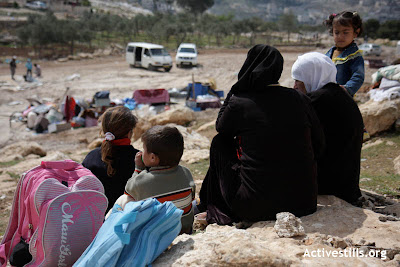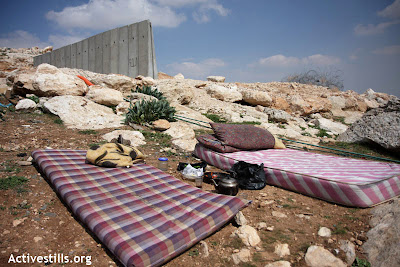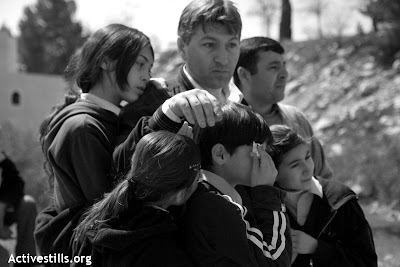




(c) Anne Paq/Activestills.org, Nilin, Land Day, 30.03.2009.
The West Bank village of Nilin commemorates Land Day by helding a demonstration on 30.03.2009. A group of Palestinians, Israelis and internationals walked through the fields holding a banner with some pictures of the Warsaw Ghetto. They were stopped by Israeli soldiers who prevented them to go further and reach the fields which belong to the village. The demonstrators refused to leave and sat on the ground. In the meantime Palestinian youth from the village started to throw stones and Israeli soldiers fired scores of tear gas inside the village.
un gout amer dans la bouche: des gaz lacrimogene mais aussi un peu d'autre chose.
Il y a des jours ici ou on se demande vraiment ce que nous faisons en Palestine, ou l'amertume et le desespoir nous gagne. Il y a des jours ou nous avons l'envie de plier bagages et de trouver une autre cause perdue. Il y a des jours ou tous les signes semblent s'accumuler vers un panneau: EXIT.
Aujourd'hui est un des ces jours. Demain qui sait?
Aujourd'hui c'etait la journee de la Terre “Land Day”. Chaque annee les Palestiniens organisent des manifestations en commemoration d'une manifestation en 1976 en Israel ou six Palestiniens avaient ete tues. L'annee derniere les manifestations avaient ete puissantes et avaient rencontre une nouvelle fois la brutalite policiere. Une des mes amies photographes avait ete battue et s'etait retrouvee a l'hopital. Cette annee je couvrais pour mon collectif activestills la manifestation de Nilin. Nilin est devenu un des points centraux de la resistance avec des manifestations organisees toutes les semaines. En une annee quatre jeunes ont ete tues et il y a deux semaines, un Americain a ete tres grievement blesse en prenant une grenade lacrymogene a haute velocite dans la tete.
Je ne partais donc pas a Nilin avec l'esprit tres tranquille.
La journee precedente on m'avait contacte quatre fois pour m'indiquer l'heure de la manifestation. Je suis arrivee pile a l'heure, mais on m'annonce alors que la manifestation va commencer a 14h. J'en profite pour visiter le vieux quartier de la ville, tandis que les journalistes et photographes des grandes agences arrivent. Je les connais tous a force de les croiser mais ils ne me parlent pas vraiment. Je lis un livre avec des citations de Martin Luther King, ces paroles puissantes resonnent et j'ai envie de les lire a haute voix. Apres tout, nous sommes a une manifestation qui est censee s'inspirer des methodes non-violentes de resolution des conflits.
A 14h il y a plus de photographes et de cameramens que de manifestants. Comme c'est Land Day les medias doivent presenter quelque chose, or il y a peu de choses organisees en Cisjordanie.
Une de mes sources m'a dit qu'il y avait une petite manifestation a Qalandia.
Pendant en moment de flottement, tous les photographes se demandent s'ils vont partir ou non devant le peu de personnes presentes. Un photographe declare avec un air tres decu qu'il n y a “meme pas de soldats”. Evidemment les confrontations c'est tres vendeur.
Moi cela fait plus de deux heures que j'attends et je me dis que cela est vraiment mal organise. Est ce les habitants de Nilin se sont lasses? Est-ce qu'ils ont ete decourages par les quatres morts? Les centaines de blesses? Les arrestations et les incursions militaires incessantes?”. Est-ce que les Palestiniens ont baisse les bras? Est-ce qu'ils penchent pour d'autres methodes? La resistance non-violente a-t-elle un avenir ici?
Tout a coup les quelques Palestiniens presents deploient une banderole ou se trouvent des photos du ghetto de varsovie avec une phrase ecrite en Allemand, en Arabe, en Anglais et en Hebreu “Pourquoi devons-nous, nous Palestiniens payer pour l'Holocauste?” (apparemment la banniere avait du etre faite lors d'une visite de la chanceliere allemande). Le groupe de manifestants, en gros une trentaine de personnes se dirige avec un peu la force du desespoir vers leurs terres en direction du Mur. Autour d'eux, comme des abeilles, les photographes et cameramens, presque aussi nombreux qu'eux essayent de prendre la meilleure photo avec en premier plan la photo emblematique du gamin de varsovie qui levent les bras. Sur le chemin, les soldats israeliens font barrage, a leur vue je me depeche de mettre de l'alcool sur mon bandana afin de me proteger des gaz lacrimogenes. Les manifestants avancent fermement a la rencontre des soldats israeliens, Un commandant s'approche et demandent aux manifestants de partir. Un Palestinien apparait tout-a-coup, fait son show en criant tres fort et apres part en disant un “massalama” au commandant israelien. J'aimerais bien comprendre tout ce qui se dit. J'ai aussi envie de crier au soldat qui tient dans sa main une grenade lacrimogene prete a etre lancee sur la foule: “Mais pourquoi tu veux faire cela? Et d'abord pourquoi es-tu la, dans un village palestinien?” Mais je reste muette, crispee sur mon appareil photo, dans l'attente de la suite qui ne pourra etre que violente. Les Palestiniens continuent de parler aux soldats, et puis ils reculent un peu et s'assoient par terre, tandis que plus loin, dans le village, nous entendons de plus en plus des tirs. Les soldats sont surment rentres dans le village. Les photographes quittent la scene et je les suis. Dans ces situations dangereuses, il vaut mieux etre a plusieurs. Sur le chemin je remarque les fleurs du printemps et la beaute des oliviers.
Nous tombons nez-anez avec des soldats qui nous ont fait signe de bien vite partir, puis nous avons trouve les lanceurs de pierre qui nous ont fait signe de se depecher car nous etions sur leur ligne de mire. Pierres et gaz lacrimogenes comment a pleuvoir. Le gaz penetre partout, il brule la peau, irrite les yeux vous donne envie de vomir. Je reste un peu au loin, je ne me sens pas trop d'attaque aujourd'hui. Apres une heure, je decide de partir. Sur le parking je retrouve un Israelien assez age et nous parlons un peu. Il me demande ce qui se passe avec les lanceurs de pierre car lui est reste avec les manifestants et leur banderole. Il m'explique qu'ils se sont assis. Les soldats ne savaient pas trop quoi faire, alors ils auraient tire au loin du gaz lacrimogene et explique a leur superieur qu'ils ont ainsi disperse la foule, alors qu'une dizaine d'individus continuaient a les defier en restant tout simplement assis sur leurs terres. Ils avaient reussi a bousculer le petit schema bien etabli des soldats, et ont ouvert ainsi une breche d'humanite.
Je ne pouvais pas croire mes oreilles que j'avais loupe cela. Moi j'avais suivi tout betement, comme un mouton, la dizaine de photographes en quete d'adrenaline et d'images choc, et j'avais delaisse ce pour quoi j'etais justement venue: la couverture des actions non-violentes contre l'occupation, dans l'espoir que cela inspire d'autres actions.
Soudain, un gout amer m'a envahi la bouche, et ne m'a pas quitte jusqu'a present, Je n'avais pas ete meilleure que ces photojournalistes en quete de sensationnel que je n'arrete pas de complaisamment critiquer. Et la fameuse maxime de Gandhi me revient en tete: “sois le changement que tu veux voir dans le monde.”
Je vais essayer de faire mieux la prochaine fois et je viens de lire un article sur des bergers Palestiniens dans le sud de Hebron, qui ont refuse de laisser leurs terres malgre les menaces des colons: ils se sont tout simplement assis. Puissent-ils, ainsi que toutes les actions non-violentes qui existent en Palestine servir d'inspiration a tous, et meme aux photographes en quete d'adrenaline.







































